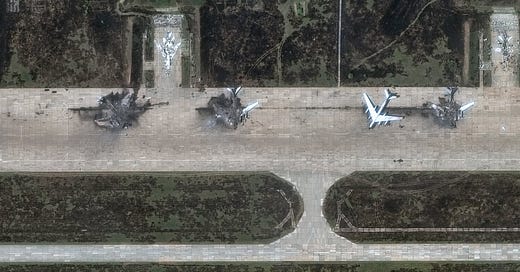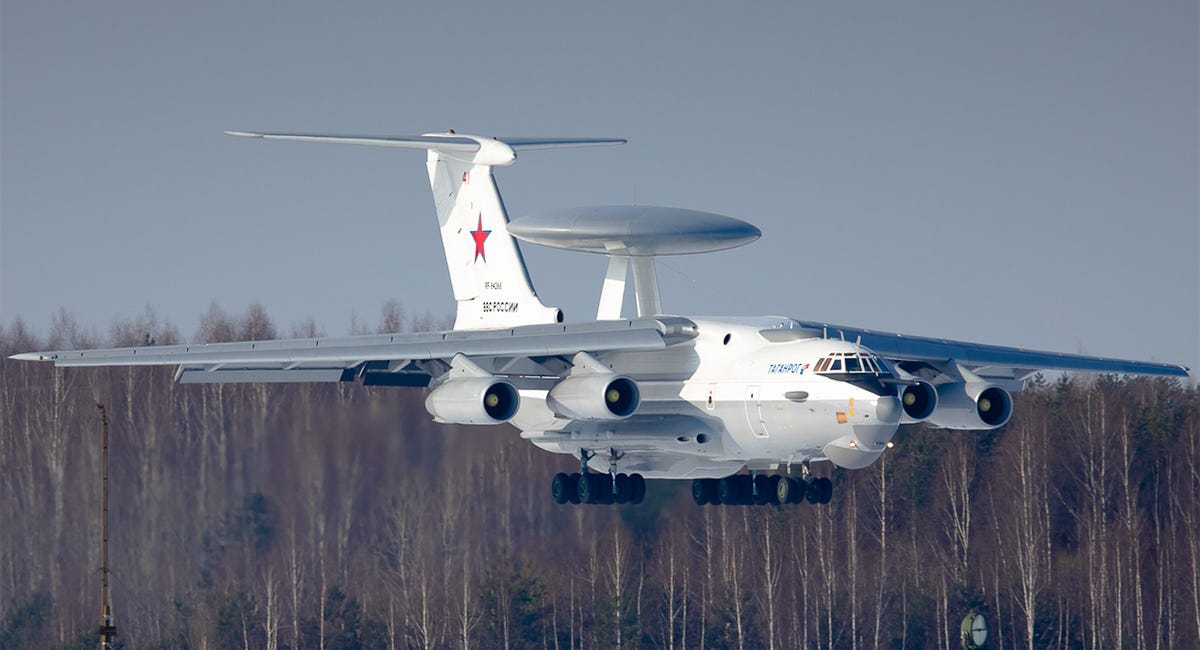Confirmed—Ukraine's Drones Blew Up At Least 1/7th of Russia's Flyable Bombers and Radar Planes
13 write-offs amount to at least 15% of the operational fleet
The Ukrainian state security agency, the SBU, initially claimed it struck 41 Russian warplanes during the agency’s Sunday special drone operation targeting five Russian air bases.
In fact, satellite imagery and close scrutiny of Ukrainian drone feeds indicate the Russians lost 14 bombers, transports and radar planes. And the radar planes may have been non-flying examples the Russians kept around as sources of spare parts.
Additional imagery may add to the tally of confirmed losses. But even 14 write-offs, 11 of which are bombers, will have a profound impact on Russian strike operations. That’s because the Russian bomber fleet, ostensibly numbering 118 Tupolev Tu-22Ms, Tu-95s and Tu-160s before the Sunday raids, has been struggling to keep planes in the air.
Now, with the loss of nearly a dozen airframes, it’s bound to get even harder for the Russians to generate flight-ready bombers.
The SBU’s roughly 100 short-range quadcopter drones, smuggled near the bases inside modified truck trailers, targeted Dyagilevo, Ivanovo, Olenya, Belaya and Ukrainka air bases—respectively 310, 470, 1,200, 2,700 and 3,700 miles from Ukraine.
The explosive quadcopters connected to their operators via Russia’s telecommunications network. The drones boasted A.I.-assisted targeting, but the maneuvers that some of the drones pulled—one even dove under the wing of a Tu-95 armed with live Kh-101 cruise missiles—indicate human operators were in the loop.
At Belaya, the drones hit four propeller-driven Tu-95s and four jet-propelled Tu-22Ms. At Olenya, they struck three more Tu-95s and an Antonov An-12 transport. At Ivanovo, two non-flying Beriev A-50 radar planes ate quadcopters. If there was any damage at Dyagilevo and Ukrainka, it’s not yet evident.
Fourteen losses might not seem like a lot for an air force that, prior to Sunday, had 56 Tupolev Tu-22Ms, 47 Tu-95s,15 Tupolev Tu-160s, seven A-50s and 59 An-12s.
But the age of the bombers and radar planes—most are at least 30 years old—plus inadequate depot maintenance means that, in practice, just half or fewer of the “active” airframes are actually combat-ready, according to Tom Cooper, an independent aviation expert.
Some sources claim just two or three A-50s are flyable. Of the four main types the SBU targeted on Sunday, just one—the Tu-160—is still in production, albeit at a very slow rate.
The Ukrainian Frontelligence Insight analysis group is a little more generous to the Russian air force. “Our team currently assesses the operational strength of the Russian strategic bomber fleet to be approximately 70 to 90 aircraft,” wrote Tatarigami, the group’s found. “A midpoint estimate puts the number at around 80.”
Chipping away
In destroying 11 flightworthy bombers and two derelict A-50s, the SBU deprived the Russian air force of potentially a third (if you believe Cooper) or 14% (if you believe Frontelligence Insight) of its operational bombers, as well as a significant proportion of the grounded A-50s whose parts keep the few functional A-50s in the air.
The Ukrainian government persists in claiming the SBU’s raids “affected” 41 Russian warplanes on Sunday. This is probably untrue.
But that doesn’t mean the SBU didn’t badly damage Russia’s long-range aviation force. The Russians now have many fewer operational bombers and fewer spare parts for the vanishing A-50 fleet.
The Ukrainian operation “should dramatically reduce Russia's ability to launch missiles against Ukrainian cities and kill civilians,” noted Ben Hodges, a retired U.S. Army general.
Tatarigami insisted the major implications will take time to manifest. “While this operation is unlikely to immediately diminish the frequency of missile strikes against Ukraine, as Russia typically employs seven to 11 bombers per salvo, it does have longer-term implications.”
“The loss of even a portion of these asset—especially ones that are difficult or almost impossible to replace—reduces Russia’s capacity for long-range force projection and its overall geostrategic flexibility.”
Read more:
Ukraine's Smuggled Drone Raid May Have Blown Up One of Russia's Last Few A-50 Radar Planes
The Russian air force began Russia’s wider war on Ukraine in February 2022 with nine active Beriev A-50sM/Us—four-engine Ilyushin Il-76 airlifters with radar radomes on their fuselages and stations for up to 15 crew and battle-managers.






